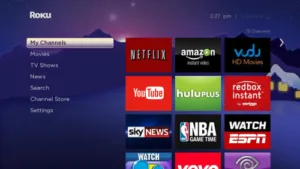Roku was explaining its strategy in the Westgate (formerly LVH/Hilton) hotel. The firm was very happy as it has signed up Haier and Best Buy Insignia to add to TCL and Hisense as adopters of its OS for TVs. The company demonstrated the simple interface that it has developed that allows full control of inputs and local hardware as well as providing streaming content through Roku’s channels (2,000 in the US, 1,400 in Canada and the UK – two thirds of them free). The company was also talking about its new UltraHD platform.
One of the key benefits that Roku provides is long term support of its boxes (they can all be upgraded to the latest specification) and it also told us that it’s overriding principles are :
- Affordability (Roku devices go from $49 to $99)
- Simplicity for the user (it is particularly proud that the remote has few buttons and no “input” button, even on TVs)
- Good Entertainment
Roku told us that it has an installed base of 10 million streamers now. Its affordability is partly the result of its very limited hardware requirements – a Roku TV can, apparently, be built on platforms with just 256K or 512K of RAM.
The company claims to be the largest supplier of media players in the US, and is now extending into Europe. The UK and Germany are the first two markets and the firm told us that the Sky Now service (OTT TV for those that don’t have Sky satellite boxes) uses the Roku technology, although the look is Sky’s own, with mentions of Roku as the supplier of some services and channels.
Display Daily Comment
I have a confession. Somehow, the fact that Roku was as strong with the Chinese TV brands just hadn’t really registered with me, although the attraction for a TV maker is clear. VOD is the top smartTV application and adopting Roku enables access to lots of content, very easily from the point of view of the TV maker. The front end is simple and attractive and implementation should be straightforward. Roku believes that, eventually, there will be just three operating systems in the TV market; whatever Samsung is choosing; Android (for those that want access to a lot more apps and offer a more complex interface); or Roku for those that want to offer a simple “lean back” experience.
We commented that the relatively lightweight hardware requirements of the Roku box and the desire to offer upgrades to existing clients really points to a “Set Top Box in the cloud“ strategy. I would guess from the smiles that comment provoked, that this is the direction for Roku (certainly as an option).
Roku followed up our meeting very quickly and, by coincidence, an HDMI stick that Roku sent me after the show arrived in the mail on the same day that a malfunction on my Sky satellite box meant that my wife’s favourite daily soaps had not been recorded. The episodes were not available on the Sky box replay service at that time, so I plugged in and configured the Roku. The process was very quick and simple and within 10 minutes I had the system working. My wife got to see her soaps.
I have good broadband connectivity (and a fast 802.11AC router), so I expected good quality. The quality of the OTT video was not as good as the satellite signal (it was softer and there was clearly a lower frame rate) and there were one or two short interruptions, but overall, it was still good enough for my wife to enjoy her soaps on a 50″ set. Impressive! (BR)

